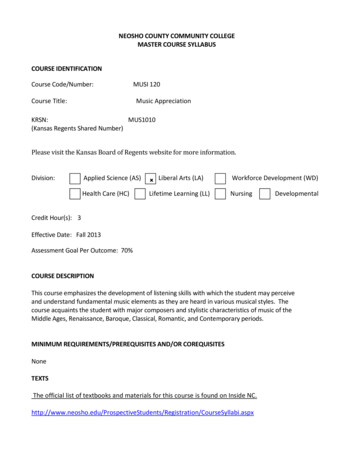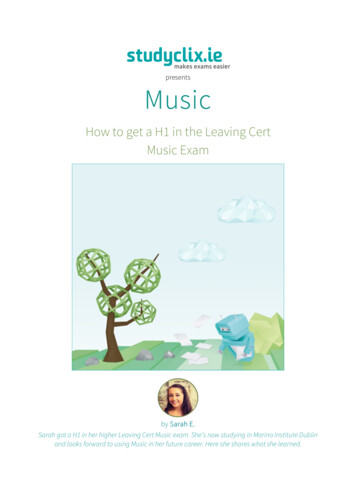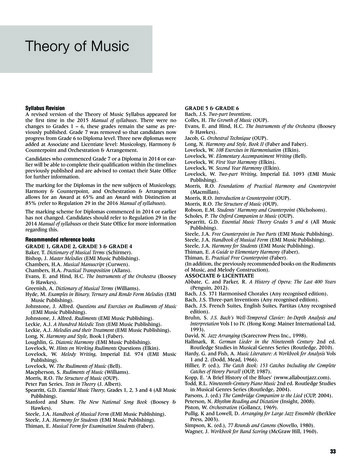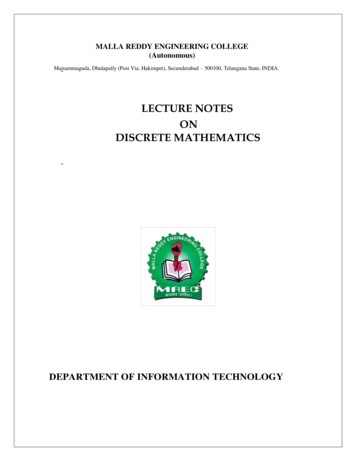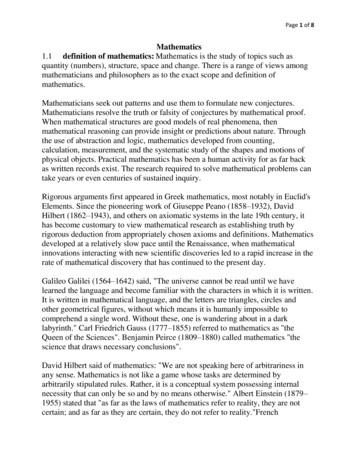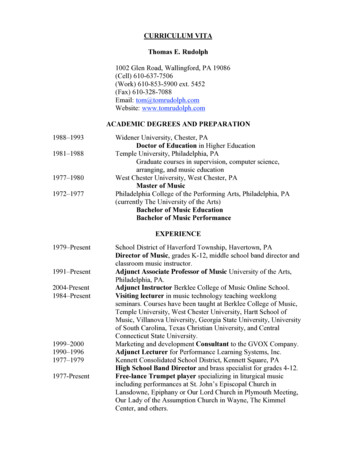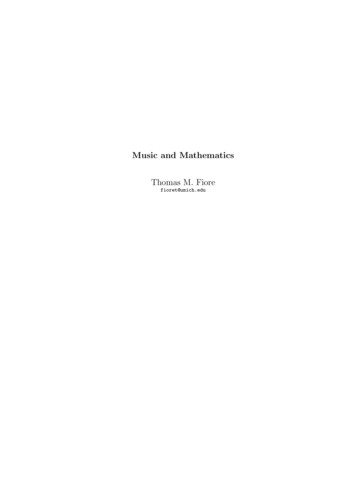
Transcription
Music and MathematicsThomas M. Fiorefioret@umich.edu
ContentsIntroduction5Lecture 1 Transposition and Inversion1. Introduction2. Mathematical Preliminaries3. The Integer Model of Pitch4. Fugue by Bach5. Tristan Prelude from Wagner777111214Lecture 1 Homework Problems1. Introduction2. Mathematical Preliminaries3. The Integer Model of Pitch4. Fugue by Bach5. Tristan Prelude from Wagner151515151616Addendum to Lecture 11. Introduction2. Fugue by Hindemith171717Addendum to Lecture 1 Homework Problems1. Introduction2. Fugue by Hindemith222222Lecture 2 The P LR Group1. Introduction2. Mathematical Preliminaries3. The P LR Group4. Elvis and the Beatles5. Topology and the Torus6. Beethoven’s Ninth Symphony7. Conclusion2424242728282932Lecture 2 Homework Problems1. Introduction2. Mathematical Preliminaries3. The P LR Group4. Elvis and the Beatles5. Topology and the Torus6. Beethoven’s Ninth Symphony7. Conclusion34343434343434353
CONTENTSBibliography436
IntroductionMusic and Mathematics are intricately related. Strings vibrate at certain frequencies. Sound waves can be described by mathematical equations. The cello hasa particular shape in order to resonate with the strings in a mathematical fashion.The technology necessary to make a digital recording on a CD relies on mathematics. After all, mathematics is the language that physicists utilize to describethe natural world and all of these things occur in the natural world. Not only dophysicists, chemists, and engineers use math to describe the physical world, butalso to predict the outcome of physical processes.Can one similarly find an “equation” to describe a piece of music? Or betteryet, can one find an “equation” to predict the outcome of a piece of music? We canmodel sound by equations, so can we also model works of music with equations?Music is after all just many individual sounds, right? Should we invest time andmoney to find these equations so that all of humankind can enjoy predictable, easilydescribed music?The answer to all of these questions is predictable and easily described: aseries of emphatic “NO’s”! There is not an equation that will model all works ofmusic and we should not spend time looking for it. Nevertheless, there are certainmathematical structures inherent in all works of music, and these mathematicalstructures are not given by equations. The language of mathematics is a convenienttool for comprehending and communicating this underlying structure.In fact, one of the central concerns of music theory is to find a good way to heara piece of music and to communicate that way of hearing.1 Anyone who has everheard Stockhausen’s Klavierstück III (1952) knows that this is not always so easy todo! On a higher level, the eighteenth century Scottish philosopher David Hume saidthat the mind receives impressions and once these impressions become tangible andvivacious, they become ideas. Music theory supplies us with conceptual categoriesto organize and understand music. Our aural impressions become vivacious ideasby way of these conceptual categories. To find a good way of hearing a musicalpiece means to comprehend the music in such a way as to make it tangible.Music theorists often draw on the formidable powers of mathematics in theircreation of conceptual categories. The discrete whole numbers . . . , 2, 1, 0, 1, 2 . . .are particularly well suited for labelling the pitches, or the keys of the piano. Thearea of mathematics called combinatorics enables one to count the many ways ofcombining pitches, i.e. numbers. This provides taxonomies and classifications of thevarious sets that arise. Group theory, another area of pure mathematics, describesthe ways that sets and pitches relate and how they can be transformed from one to1John Rahn. Basic Atonal Theory. New York: Schirmer Books, 1980. See page 1.5
INTRODUCTION6the other. It is in this sense that pure mathematics provides a convenient frameworkfor the music theorist to communicate good ways of hearing a work of music.Music theory is not just for the listener. Music theory is also useful to thecomposer. Bach, Mozart, and Beethoven were well versed in the music theory oftheir respective epochs and applied it daily. This abstract discussion has relevancefor the performing artist as well. A classical pianist may play thousands uponthousands of notes in one concert, all from memory. How does a classical pianistdo that? Is it necessary for the classical pianist to memorize each individual note?Of course not. Music theory provides the performing artist with an apparatus forpattern recognition, and this strengthens the musical memory. A piece of musicdoes not consist of many individual isolated sounds, but rather several ideas woventogether. One can find the thread of the musical fabric with music theory. On theother hand, this same musical memory allows the listener to conceive of a piece ofmusic as a whole, rather than isolated individual events. Music theory is not limitedto classical music. Jazz musicians also use music theory in their improvisations andcompositions. Non-western music also lends itself to analysis within the frameworkof music theory.In this module we investigate some of the group theoretical tools that musictheorists have developed in the past 30 years to find good ways of hearing particularworks of music. Group theory does not provide us with equations to describe a pieceof music or predict its outcome. Instead, it is just one conceptual category thatlisteners, composers, and performers can use to make sense of a work of art and tocommunicate ways of hearing to others. The aural impression of a piece of musicbecomes an idea in the sense of Hume with this apparatus.In the next two lectures we will study the T /I and P LR groups and use themto analyze works of music from Johann Sebastian Bach, Ludwig van Beethoven,Richard Wagner, and Paul Hindemith. This group theoretical point of view willelevate our aural impressions to the status of ideas. We will conceive of the musicnot as individual sounds, but at as a whole. The mathematical framework willprovide us with a way of hearing the pieces and a means of communicating thishearing.These notes were prepared for a series of three guest lectures in the undergraduate course Math 107 at the University of Michigan under the direction of KarenRhea in Fall 2003. These lectures were part of my Fourth Year VIGRE Projectaimed at introducing undergraduates to my interdisciplinary research on generalizedcontextual groups with Ramon Satyendra. I extend my thanks to Ramon Satyendra of the University of Michigan Music Department for helpful conversations inpreparation of this module.
Lecture 1 Transposition and Inversion1. IntroductionSome of the first mathematical tools that music students learn about are transposition and inversion. In this introductory lecture we learn about the mathematical concepts necessary to formalize these musical tools. These concepts includeset, function, and modular arithmetic. Musicians are usually come into contactwith transposition and inversion in the context of pitch. To bridge the gap betweensound and number we will conceive of the integer model of pitch as musicians normally do. After the mathematical discussion we turn to examples from Bach andWagner.2. Mathematical PreliminariesThe mathematical concepts of set, function, domain, range, and modular arithmetic will be needed for our discussion.2.1. Sets and Functions.Definition 2.1. A set is a collection of objects. The collection of objects iswritten between curly parentheses {}. The objects of the set are called elements.Two sets are said to be equal if they have the same elements.For example, the set {4, 5, 10} is the set consisting of the numbers 4, 5, 10 andnothing else. The set {A[, B[} is the set whose elements are the two pitch classesA[ and B[. The symbols }6, 100, 11, 5} do not denote the set whose elements arethe numbers 6, 100, 11, 5 because one of the parentheses is the wrong way. Theorder of the elements of a set does not matter. For example,{4, 5, 10} {5, 4, 10} {10, 4, 5}.The sets {56, 70} and {56} are not equal because they do not have the same elements(the second set is missing 70).A function gives us a rule for getting from one set to another.Definition 2.2. A function f from a set S to a set S 0 is a rule which assignsto each element of S a unique element of S 0 . This is usually denoted by f : S S 0 .This symbolism is read: “f goes from S to S 0 .” In this situation, the set S is calledthe domain of the function f and S 0 is called the range of the function f . Theinputs are the elements of the domain. The outputs are the elements of range.For example, consider the function f : {1, 2, 3} {4, 5} defined byf (1) 4f (2) 57
2. MATHEMATICAL PRELIMINARIES8f (3) 4.Here the domain is the set S {1, 2, 3} and the range is the set S 0 {4, 5}. Thesethree equations tell us the rule that assigns an output to each input. Note thateach element 1, 2, 3 of the domain gets a unique output, i.e. f (1) does not have twodifferent values. In precalculus we like to say that the function passes the verticalline test. The definitiong(1) 4g(1) 5g(2) 4g(3) 4does not define a function g : {1, 2, 3} {4, 5} because two different values 4 and5 are assigned to 1. The definitionh(1) 4h(2) 4h(3) 4does define a function h : {1, 2, 3} {4, 5} because a unique output is assigned toeach input. Note that the same output is assigned to each input and 5 is not evenused.Functions can be composed, provided the domain of one is the range of theother. For example, if j : {4, 5} {7, 8, 9} is given by the rulej(4) 9j(5) 8and f is as above, then we get a new function j f : {1, 2, 3} {7, 8, 9} called thecomposition of j with f defined by j f (x) j(f (x)). In this example we havej f (1) j(f (1)) j(4) 9j f (2) j(f (2)) j(5) 8j f (3) j(f (3)) j(4) 9.Sometimes functions are given by formulas rather than tables. In the nextsection we will see some functions that are given by formulas.2.2. Modular Arithmetic.Consider the face of a clock with the numbers 0 through 11 where 0 is in the12 o’clock position. The day starts at midnight, so we have replaced 12 by 0 onthe usual face of a clock. Using the clock, we can determine what time it is 2 hoursafter 1. We just go clockwise 2 notches after 1 and we get 3. Similarly 5 hours after6 is 11. But what about 1 hour after 11? Well, that is 0 because we are back atthe beginning. Similarly, 2 hours after 11 is 1. This is called arithmetic modulo 12.Summarizing, we can write1 2 3 mod 126 5 11 mod 1211 1 0 mod 1211 2 1 mod 12.
2. MATHEMATICAL PRELIMINARIES9Whenever it is clear that one is working mod 12, we just leave off the suffix mod12. So we have just done addition mod 12, let’s consider subtraction. If we bringsome of the numbers over to the right like usual arithmetic, we get1 3 26 11 511 0 111 1 2where we leave off mod 12 because it is clear by now that we are talking aboutarithmetic modulo 12 in this paragraph and not arithmetic modulo 7. The firsttwo equations appear to make sense to us from usual arithmetic. But to makesense of the last two equations, we need to consider the face of the clock. If we areat 0 o’clock and go back 1 hour, then we are at 11 o’clock. Similarly, if we are at 1o’clock and go back to hours, we just go counterclockwise two notches on the faceof the clock and arrive at 11 o’clock. That is why 11 0 1 and 11 1 2.Given any number, we can find out what it is mod 12 by adding or subtracting12 enough times to get a whole number between 0 and 11. For example, 12 0 12 24 13 1 11 23 7 5 17 29.As a result, mathematicians and musicians use the notationZ12 {0, 1, 2, 3, 4, 5, 6, 7, 8, 9, 10, 11}and call this set the set of integers mod 12.Maybe you can guess that we are interested in integers mod 12 because thereare twelve keys on the piano from middle C to the next C not counting the lastC. All of this has an aural foundation. Our ears naturally hear pitches that are anoctave apart, i.e. pitches with 12 jumps (or intervals) between them on the piano.Such pitches appear to be very similar for our ears. So in a sense, our human earsare hardwired for arithmetic mod 12!We are also interested in arithmetic modulo 7 because there are seven pitchesin the major scale, i.e. seven white keys on the piano from middle C to the nextC. For arithmetic modulo 7 we imagine there are seven hours in a day and thatthe face of the clock goes from 0 to 6 instead of 0 to 11. Arguing as in the mod 12case, we have1 2 3 mod 76 5 4 mod 76 1 0 mod 76 2 1 mod 7.We already see a difference between mod 12 and mod 7. Notice that6 5 11 mod 12 but 6 5 4 mod 7. Let’s consider some examples of subtraction.If we bring some of the numbers to the right like in usual arithmetic, we get1 3 2 mod 76 4 5 mod 76 0 1 mod 76 1 2 mod 7.
2. MATHEMATICAL PRELIMINARIES10Subtraction can be understood by moving counterclockwise on the face of a clockwith seven hours labelled 0, 1, . . . , 6.Given any number, we can find out what it is mod 7 by adding or subtracting7 enough times to get a number between 0 and 6. For example, 7 0 mod 7 9 2 5 mod 715 8 1 mod 717 10 3 mod 7.As a result, mathematicians and musicians use the notationZ7 {0, 1, 2, 3, 4, 5, 6}and call this set the set of integers mod 7.Next we can talk about functions f : Z12 Z12 . These are functions whoseinputs are integers modulo 12 and whose outputs are also integers modulo 12. Let’sconsider the function T2 : Z12 Z12 defined by the formula T2 (x) x 2. Recallthat we considered functions given by tables in Subsection 2.2 above. We can makea table for this function as follows.T2 (0) 0 2 2 mod 12T2 (1) 1 2 3 mod 12T2 (2) 2 2 4 mod 12T2 (3) 3 2 5 mod 12T2 (4) 4 2 6 mod 12T2 (5) 5 2 7 mod 12T2 (6) 6 2 8 mod 12T2 (7) 7 2 9 mod 12T2 (8) 8 2 10 mod 12T2 (9) 9 2 11 mod 12T2 (10) 10 2 0 mod 12T2 (11) 11 2 1 mod 12.Another function I0 : Z12 Z12 is given by the formula I0 (x) x. For exampleI0 (1) 11 and I0 (6) 6.This concludes the introduction of sets, functions, and modular arithmeticnecessary for an understanding of transposition and inversion. Finally we can turnto some music.
3. THE INTEGER MODEL OF PITCH113. The Integer Model of PitchTo make use of the mathematical ideas developed in the last section, we need totranslate pitch classes into numbers and introduce transpositions and inversions.2If you can’t read music, don’t panic, just use the integers modulo 12. If you canread music, then the following well established dictionary shows us how to get frompitches to integers modulo 12.C 0C] D[ 1D 2D] E[ 3E 4F 5F ] G[ 6G 7G] A[ 8A 9A] B[ 10B 11In this integer model of pitch, the C major chord {C, E, G} is {0, 4, 7}. ThisC major chord is part of the main theme for Haydn’s Surprise Symphony. Thefirst part of the main theme is hC, C, E, E, G, G, E, F, F, D, D, B, B, Gi, which canbe written h0, 0, 4, 4, 7, 7, 4, 5, 5, 2, 2, 11, 11, 7i. These angular brackets hi are oftenused by music theorists to emphasize that the notes occur in this order. Recall thatthe ordering does not matter for sets, because a set is just a collection of elements.Unordered sets, e.g. {0, 4, 7}, are sometimes called pcsets (pitch class sets) whileordered sets such as h0, 0, 4, 4, 7, 7, 4, 5, 5, 2, 2, 11, 11, 7i are called pcsegs (pitch classsegments).Transpositions and inversions are functions Z12 Z12 that are useful to everymusician. There are also analogues for Z7 . Transposition and inversion are oftenapplied to melodies, although they can also be applied to chords. When we hear amelody consisting of several pitches, we hear the intervals between the individualnotes. The relationship between these intervals is what makes a melody appealingto us. Transposition mathematically captures what musicians do all the time: therestatement of a melody at higher and lower pitch levels in a way that preservesintervals. Inversion is another way to create musical variation while preserving theintervallic sound of a melody, although it does not preserve the exact intervals.Definition 3.1. Let n be an integer mod 12. Then the function Tn : Z12 Z12defined by the formula Tn (x) x n mod 12 is called transposition by n.2In music theory, particularly in atonal theory, it is common to study pitch classes rather thanpitches. One can see the difference between pitch classes and pitches in the following example.Middle C is a particular pitch, although the pitch class C refers to the aggregate of all keys onthe piano with letter name C.
4. FUGUE BY BACH12We already came into contact with T2 : Z12 Z12 in the previous section.Some examples for T5 : Z12 Z12 areT5 (3) 3 5 8T5 (6) 6 5 11T5 (7) 7 5 0T5 (10) 10 5 15 3where we have not written mod 12 because it is clear from the context.Definition 3.2. Let n be an integer mod 12. Then the function In : Z12 Z12defined by the formula In (x) x n is called inversion about n.We already came into contact with I0 : Z12 Z12 in the previous section.Some examples for I7 : Z12 Z12 areI7 (3) 3 7 4I7 (7) 7 7 0I7 (9) 9 7 2 10.The function In is called inversion about n because it looks like a reflection aboutn whenever one draws the number line.Music theorists and composers like to transpose and invert entire pcsets orpcsegs by applying the function to each element. For example, we can transpose aC major pcset by 7 steps as inT7 {0, 4, 7} {T7 (0), T7 (4), T7 (7)} {0 7, 4 7, 7 7} {7, 11, 2}by applying T7 to each of 0,4, and 7. A musician would notice that this takes theC major chord to the G major chord. Similarly, we could invert the pcseg for thetheme of Haydn’s Surprise Symphony about 0, although Haydn did not do this!I0 h0, 0, 4, 4, 7, 7, 4, 5, 5, 2, 2, 11, 11, 7i h0, 0, 8, 8, 5, 5, 8, 7, 7, 10, 10, 1, 1, 5iIn this section we have introduced the integer model of pitch, which assigns toeach of the 12 pitch classes an integer mod 12. The transpositions and inversionsare functions which have inputs and outputs that are pitches. These are conceptualcategories that music theorists use to find good ways of hearing pieces. Next weuse them to find good ways of hearing a fugue and a prelude.4. Fugue by BachJohann Sebastian Bach (1685-1750) took the art of fugue to new heights. Hecomposed the Well-Tempered Clavier Book I and the Well-Tempered Clavier BookII, each of which contains 24 preludes and fugues. A fugue usually begins with astatement of the main theme called the subject. This subject returns over and overagain in various voices and usually they are thread together in complex way. Everyfugue has occurrences of transposition and inversion. A truly fascinating websitehttp : //jan.ucc.nau.edu/ tas3/bachindex.htmlon Bach describes in detail what a fugue is. Click on the link for movies on theWell-Tempered Clavier. There is an animation and recording for Fugue 6 in dminor of the Well-Tempered Clavier Book I, which we now analyze. Our analysis
4. FUGUE BY BACH13will be restricted to finding some transpositions and inversions, since we are onlystudying some of the mathematical structure. We’ll leave detailed analysis to themusic theorists.The subject of the fugue is the pcseghD, E, F, G, E, F, D, C], D, B[, G, Ai h2, 4, 5, 7, 4, 5, 2, 1, 2, 10, 7, 9iwhich begins in measure 1 and lasts until the beginning of measure 3. Let’s callthis pcseg P . See the score that you got in class. Interestingly enough, this subjectconsists of twelve notes! In measure 3, another voice sings the melodyhA, B, C, D, B, C, A, G], A, F, D, Ei h9, 11, 0, 2, 11, 0, 9, 8, 9, 5, 2, 4i.Do you see a relationship between this pcseg and P ? Notice that this pcseg isT7 P ! Just try adding 7 to each element of P and you will see it. In measure 6, thesubject returns in the exact same form as the introduction, just one octave lower.At measure 8, a formhE, F, G, A, F, B[, G, F ], G, E[, C], Di h4, 5, 7, 9, 5, 10, 7, 6, 7, 3, 1, 2iof the subject enters. This one doesn’t entirely match though. The first five pitchesare almost T2 of the first five pitches of P , but the next 5 pitches are T5 of therespective pitches of P . The last pitch of the pcseg is also T5 of the respective pcsegof P , but the eleventh pitch doesn’t match. At measure 13 we havehA, B, C], D, B, C], A, G], A, F, D, Ei h9, 11, 1, 2, 11, 1, 9, 8, 9, 5, 2, 4i.This is similar to T7 P as in measure 3, except for the highlighted 1’s. Measures17,18, and 21 are respectivelyhA, B, C, D, B, C], A, G], A, F, D, Ei h9, 11, 0, 2, 11, 1, 9, 8, 9, 5, 2, 4ihA, B, C], D, B, C, A, G], A, F, D, Ei h9, 11, 1, 2, 11, 0, 9, 8, 9, 5, 2, 4ihA, B, C], D, B, C], A, G], A, F, D, Ei h9, 11, 1, 2, 11, 1, 9, 8, 9, 5, 2, 4i.These are also T7 P except for the highlighted 1’s. The interval 7 is very importantin western music and is called the perfect fifth. Here we see that transposition bya perfect fifth occurs four times before the piece is even half over. In fact, manyfugues have this property. So far we have seen that transposition plays a role inthis piece. But what about inversion?Let’s consider measures 14 and 22. They are respectivelyhE, D, C], B, D, C], E, F, E, A, C, B[i h4, 2, 1, 11, 2, 1, 4, 5, 4, 9, 0, 10ihE, D, C], B, D, C], E, F, E, G, B[, Ai h4, 2, 1, 11, 2, 1, 4, 5, 4, 7, 10, 9i.They are nearly identical, except for the last three digits. Notice also that the firsttwo elements E, D are the same first two elements of P , just the order is switched.The last three notes of 22 are even the last three notes of P , just the order isswitched. Calculating I6 P givesh4, 2, 1, 11, 2, 1, 4, 5, 4, 8, 11, 9iwhich is a near perfect fit with measures 14 and 22! Just the last three notes arechanged to make it sound better. So we see that inversion does indeed play a rolein the piece. The rest of the piece contains further transpositions and inversions ofthe subject.Next time we listen to the piece, we can listen for these transposed and invertedforms of the subject. These conceptual categories make the piece more enjoyable for
5. TRISTAN PRELUDE FROM WAGNER14listeners because we come closer to understanding it. We have a good way of hearingthe piece. This knowledge also makes the piece easier for performers because theyrecognized patterns and relationships between different parts of the piece. However,a music theorist would not be satisfied with this analysis because we have barelyscratched the surface. There is much more to this fugue than a few transpositionsand inversions. Nevertheless, this illustrates some of the mathematical features ofthe piece.5. Tristan Prelude from WagnerRichard Wagner (1813-1883), who was born 63 years after the death of Bach, isbest known for his gigantic operas. Wagner’s compositions are drastically differentfrom Bach’s. We take the prelude to the famous opera Tristan and Isolde as anexample for transposition and inversion. This particular passage is notorious forits resistance to traditional analysis.3 More modern methods of atonal analysis,which use transposition and inversion, are more fruitful. In this analysis we consider unordered sets, i.e. pcsets, although we worked with pcsegs in the previousexample.4Consider the piano transcription of the first few measures of the prelude. Thepiano transcription entitled “Wagner: Tristan Prelude” is in the packet of music Ihanded out in class. Let Pi denote the set of pitch classes that are heard duringthe circle i on the piano transcription. For example, P2 {F, B, D], A}. Then wenotice the following pattern after looking very carefully.P1P2P3P4P5P6P7P8P9P12P13{0, 2, 5, 8} {0, 2, 6, 8} {0, 2, 6, 8} {0, 2, 5, 8}This table means that all of the pcsets in the first column can be transposedor inverted to {0, 2, 5, 8}, all of the pcsets in the second column can be transposedor inverted to {0, 2, 6, 8}, etc. Notice that the first and last column are essentiallythe same, while the middle two columns are essentially the same! Here, essentiallymeans they can be transposed or inverted to the same thing.Notice also that everything is done according to the groups of circled notes inthe music, and we almost have three groups of four, which would give us 12 again!The first and last pitches of each four note group, namely G] B, B D, andD F ], also form a set that can be transposed or inverted to {0, 2, 5, 8}!In other words, we mathematically see and musically hear a self similarity ondifferent levels. When we listen to the piece again, we can listen for these features.The conceptual categories of transposition and inversion provide us with a goodway of hearing these introductory measures to Wagner’s opera Tristan and Isolde.Mathematics is the tool that we use to communicate this way of hearing to others.3This analysis is obtained from John Rahn page 78, who in turn quotes Benjamin Boretz.4What works for one piece of music may not work for another. In the Bach fugue it wasbetter to use pcsegs because the pcsets would tell us very little in that case. However, pcsets aremore appropriate for the Tristan prelude than pcsegs.
Lecture 1 Homework Problems1. Introduction1. Reread the introduction to this music module. Is music part of the physicalworld? Write a short paragraph on this topic.2. Mathematical Preliminaries2.1. Sets and Functions.2. Give three examples of sets that are not listed in the text.3. Give two functions whose domain is {5, 4, 7} and whose range is {1, 2}. Youwill probably want to use tables.4. Is there a function with f (4) 5 and f (4) 7?2.2. Modular Arithmetic.5. Do the following calculations mod 12. Your answers should be numbersbetween 0 and 11. The numbers 0 and 11 may also be answers!7 51 48 86 69 77 92 8.3. The Integer Model of Pitch6. Use the integer model of pitch to rewrite the following melody in “HeavenlyAida” in Act I of Verdi’s opera Aida: hG, A, B, C, D, G, Gi.7. Use the integer model of pitch to rewrite the following melody in the “Toreador Song” in Act II of Bizet’s opera Carmen: hC, D, C, A, A, A, G, A, B[, A, B[, G, Ci.8. Calculate T4 (3), T1 (2), T8 (7), I4 (6), I4 (8).15
5. TRISTAN PRELUDE FROM WAGNER169. Transpose the melody above from “Heavenly Aida” a perfect fifth by applying T7 to each element.10. Invert the melody above in the “Toreador Song” about 6 by applying I6 toeach element.11. Calculate T5 I3 (4) and I3 T5 (4). Are they the same?4. Fugue by Bach12. Look at the website on Bach listed in the text.5. Tristan Prelude from WagnerChallenge: The unordered pcsets P9 and P13 on the piano transcription of theTristan Prelude areP9 {C, F, G], D}P13 {B, D], A, F ]}.Translate these pcsets to integers mod 12. Find an integer n such that In (P9 ) P13 .You may have to change the ordering of the elements of the set.
Addendum to Lecture 11. IntroductionWe consider a further application of transposition and inversion in music theory.Thus far we have considered only composers who have lived before the 20th century,so it is high time we consider someone who is closer to our time.2. Fugue by HindemithPaul Hindemith (1895-1963) was known as a champion of contemporary musicand a promoter of early music. In 1941, just 5 years before becoming a U.S.citizen, he composed Ludus Tonalis. This is a collection of 12 fugues with eleveninterludes, framed by a prelude and a postlude. Such a collection of fugues remindsone immediately of Bach’s Well-Tempered Clavier, although Hindemith also hadmore modern ideas of symmetry and symmetry breaking in mind. The title LudusTonalis means Tonal Game in Latin, and this can be seen in the symmetry andasymmetry of individual pieces as well as in the collection as a whole. One of themost striking features of the collection is that the postlude is exactly the same asthe prelude except upside down and backwards!Paul Hindemith also had an interesting life. An excellent websitehttp : //www.hindemith.org/on Hindemith describes his trips to Egypt, Turkey, and Mexico, his flight from theNazis, and his emigration to the United States. The website also has historicalphotos and references to literature.Hindemith’s Fugue in G provides us with further examples of transpositionand inversion, although we will encounter difficulties. This example will illustratesome of the difficulties that music theorists encounter and how they get aroundsome of these difficulties. Hindemith’s fugue will also be a warm-up for the nextlecture on the P LR group. Professor Ramon Satyendra and I have recently createda theoretical apparatus to treat musical difficulties such as the one we are about tostudy.5The Fugue in G begins with a statement of the subject as in Bach’s Fugue ind-minor. The subject ishG, G, G, G, G, G, G, C, D, G, C, F i h7, 7, 7, 7, 7, 7, 7, 0, 2, 7, 0, 5iand consists of eleven notes and five pitches in two measures which have five beatseach (all prime numbers!). The subject is very prominent because the repeated Gat the beginning tells us the voice is entering. When we listen to the piece, we5Thomas M. Fiore and Ramon Satyendra. “Generalized Contextual Groups.” To appear inMusic Theory Online.17
2. FUGUE BY HINDEMITH18can listen for that repeated staccato note and we will easily find occurrences ofthe subject. For example, one quickly hears that measures 3, 8, and 15 containrepeated notes which begin occurrences of the subject.Instead of comparing occurrences of the subject as in Bach, we will look at asmaller unit. The two three-note groups at the end of the subject are also veryprominent to our ears. In this analysis we will consider the relationships betweenthese three-note groups in the various occurrences of the subject. These relationships are given by the conceptual categories transposition, invers
together. One can flnd the thread of the musical fabric with music theory. On the other hand, this same musical memory allows the listener to conceive of a piece of music as a whole, rather than isolated individual events. Music theory is not limited to classical music. Jazz musicians also use music theory in their improvisations and compositions.
